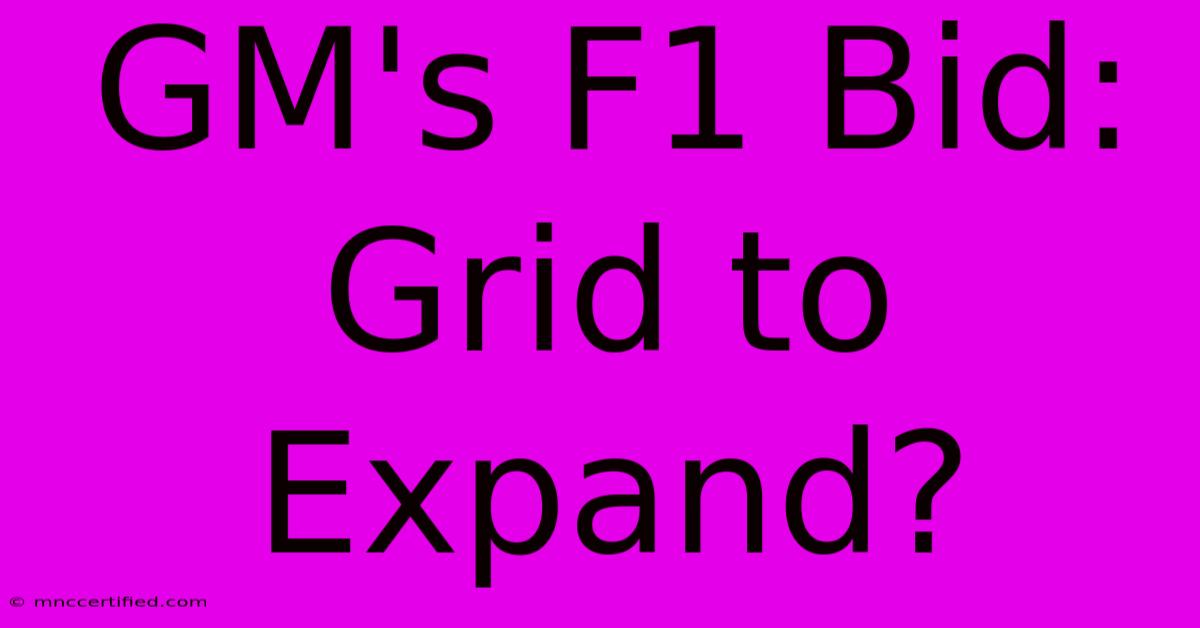GM's F1 Bid: Grid To Expand?

Table of Contents
GM's F1 Bid: Grid to Expand? The Future of Formula 1
The motorsport world is abuzz with speculation following reports that General Motors (GM), through its Cadillac brand, is seriously considering entering Formula 1. This potential entry isn't just a rumour; it represents a seismic shift that could dramatically reshape the F1 grid and its future. But will this ambitious bid lead to an expansion of the grid, and what are the implications?
Cadillac's F1 Ambition: More Than Just a Rumor
The whispers have grown into a roar. Reports suggest Cadillac is actively exploring a Formula 1 entry, potentially as early as 2026. This isn't a small player; GM is a global automotive giant, bringing significant financial resources and engineering expertise to the table. Their involvement would inject a powerful new energy into the sport, attracting new fans and sponsors.
The Allure of F1 for a Global Brand like Cadillac
For Cadillac, an F1 entry offers unparalleled global brand exposure. Formula 1 boasts a massive, worldwide fanbase, reaching millions of viewers across diverse demographics. Association with this prestigious motorsport series elevates Cadillac's image, associating it with cutting-edge technology, innovation, and high performance. This is a powerful marketing strategy, perfectly aligning with Cadillac's luxury positioning.
The Technical Challenges and Opportunities
Entering F1 requires more than just a big budget. Cadillac will need to overcome significant technical hurdles. The sport demands the highest levels of engineering prowess and innovation. However, the challenge is also a considerable opportunity. Success in F1 translates to advancements in vehicle technology that can be leveraged across GM's entire product line, boosting performance and efficiency.
Will the F1 Grid Expand? The Implications of Cadillac's Entry
The current F1 grid consists of 10 teams. The addition of a new team like Cadillac would necessitate a potential expansion. However, Formula 1's governing body, the FIA, would need to carefully consider the implications of such an expansion.
Pros and Cons of Grid Expansion
Pros:
- Increased Competition: More teams mean more on-track battles, making the races more exciting and unpredictable.
- Greater Global Reach: A new team from a major automotive market like the US could attract new fans and sponsors worldwide.
- Economic Boost: An expanded grid would generate more revenue for the sport and its stakeholders.
Cons:
- Logistical Challenges: Expanding the grid would require adjustments to race formats, logistical planning, and potentially even track infrastructure.
- Dilution of Resources: A larger grid could potentially dilute the resources available to each team, impacting competitiveness.
- Fairness Concerns: Ensuring a level playing field between established teams and newcomers is crucial to maintain the sport's integrity.
The Future: A Cadillac-Powered F1 Revolution?
The possibility of Cadillac joining Formula 1 is undeniably exciting. Their entry has the potential to reshape the sport's landscape, bringing increased competition, greater global reach, and technological innovation. Whether the grid will expand remains to be seen. The FIA will need to carefully weigh the pros and cons before making a decision. But one thing is clear: the future of Formula 1 is looking increasingly dynamic and potentially revolutionary.
Keywords: GM, General Motors, Cadillac, F1, Formula 1, grid expansion, motorsport, automotive, FIA, new team, brand exposure, technical challenges, global fanbase, competition, revenue, future of F1, 2026 F1 season.

Thank you for visiting our website wich cover about GM's F1 Bid: Grid To Expand?. We hope the information provided has been useful to you. Feel free to contact us if you have any questions or need further assistance. See you next time and dont miss to bookmark.
Featured Posts
-
Rooneys Net Worth Plymouth Deal Man Utd
Nov 23, 2024
-
South Carolina Liquor Insurance
Nov 23, 2024
-
Dione Protocol Price Prediction
Nov 23, 2024
-
Lender Vs Owner Title Insurance
Nov 23, 2024
-
Lamars Surprise Album Released
Nov 23, 2024